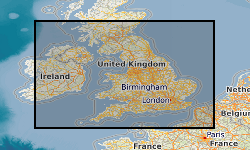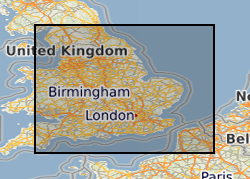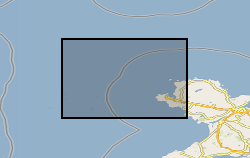Sea floor
Type of resources
Available actions
Topics
Keywords
Contact for the resource
Provided by
Years
Formats
Representation types
Update frequencies
Service types
Scale
-

High velocity friction experiments. In this study, new samples recovered by IODP (Integrated Ocean Drilling Program) Exp. 362 from incoming Indian plate sediments will be used to investigate the frictional behavior of these sediments en-route to the plate boundary interface. The UK IODP Moratorium award will be used to achieve 5 Strategic Objectives: SO 1 - identify the characteristics of the sedimentary sections to optimize the sampling strategy for friction experiments based upon onboard sedimentology, petrology, geochemistry and in-situ logging profiles. This objective will benefit from the Exp. 362 Science Party work carried out during the cruise. SO 2 - acquire a quantitative data set of the mineral assemblages, fluid permeability, and porosity for each sample. SO 3 - measure their frictional dependence on slip, slip rate, slip velocity, and normal stress by performing experiments on the collected samples under deformation conditions typical of earthquakes using the high velocity rock friction apparatus SHIVA. SO 4 - monitor gas emission, humidity, and temperature variations during friction experiments using mass spectrometry, temperature and humidity measurements with the sensors installed on the rotary shear apparatus. SO 5 - analyse the experimental fault rock material using a multidisciplinary approach that involves microstructural analysis, mineralogy, and petrology so that proxy records may be reconstructed for plate interface seismic slip. Validate these against the seismological record. The ultimate goal is to incorporate the actual physical properties of the Sumatra-Andaman incoming sedimentary section within an improved theoretical earthquake rupture propagation model. This research will develop a new approach to the assessment of extreme near-trench tsunamogenic slip based on the analysis of incoming plate sediments. This approach is also applicable to other plate-boundary megathrusts (e.g. Japan Trench, Barbados). Future studies can also consider possible lateral variations in the lithological composition of the incoming plate/subduction plate boundary material.
-

The Seabed Geology 10k: Bristol Channel is a digital geological map portraying the distribution of the different geological substrate units (either of bedrock or unlithified deposits) present on the seabed at a 1:10 000 scale. Additionally, to the Seabed Substrate layer, this dataset also includes i) a Geomorphology layer, revealing the presence and distribution of seabed morphological and geomorphological features and ii) a Structural Geology layer, that delineates the principal structural features observed at rockhead. The bedrock geology is divided into seven stratigraphical units: Pembroke Limestone Group (PEMB); Mercia Mudstone Group (MMG); Penarth Group (PNG); the Lias Groups' St Mary’s Well Bay (STM), Lavernock Shales (LVN) and the Porthkerry (PO) members; and the Inferior Oolite Group (INO). The Lexicon code of the stratigraphical units is provided in parentheses, as defined in the ‘BGS Lexicon of Named Rock Units’. The superficial deposits mapped are comprised of only marine sediments that were classified based on their grain size. However, Folk classification was not used to define the sediment classes. The sediments are divided into Gravel (V); Sand and Gravel (XSG); Sand (S); Sand and Mud (XSM); Mud (M); and Gravel, Sand and Mud (XVSM). The RCS code of the stratigraphical units is provided in parentheses, as defined in the ‘BGS Rock Classification Scheme’.
-

The BGS Seabed Geology: Offshore East Anglia digital map provides detailed and accurate characterisation of the seabed geology, based on seabed and shallow-subsurface data. This dataset incorporates three complementary map components (Substrate Geology, Structural Geology, and Geomorphology), provided as discrete layers for viewing within a Geographic Information System (GIS). The bedrock geology of the mapped area comprises Cretaceous age Chalk Group sedimentary rocks. These rocks crop out extensively at seabed across the southern and central parts of the dataset forming an extensive bedrock platform and Europe’s largest known offshore chalk reef. This reef has been designated the Cromer Shoal Chalk Beds Marine Conservation Zone (MCZ) owing to the range of unique floral and faunal habitats that it supports. The Chalk Group is covered across the central (partly) and southern parts of the dataset by natural superficial deposits that accreted during the Quaternary. These include preglacial delta bottom-set (Westkapelle Ground Formation) and delta top-set (Yarmouth Roads Formation); and glacial sediments and landforms that were deposited and formed during at least two separate phases of glaciation that inundated parts of the southern North Sea and adjacent East Anglia during the Middle Pleistocene (Anglian / Elsterian) and Late Pleistocene (Late Devensian / Late Weichselian). Collective geological evidence includes extensive areas of out-cropping subglacial till; the presence of largely concealed and infilled over-deepened (>100 m deep) subglacial tunnel valleys, ice-marginal moraines, and a glacially disrupted chalk surface that includes the development of incised meltwater channels, detached and transported glacitectonic bedrock rafts and megablocks. Post-glacial environments from the Late-Pleistocene – Holocene (prior to marine inundation) included fluvial and estuarine deposition, that together with variable infill of late-glacial valleys are included within the Botney Cut Formation. Holocene marine transgression flooded the region, with shallow marine sedimentation active through modern times resulting in the variable cover of unconsolidated marine sediments, as well as the distribution of extensive current-induced bedforms, e.g., sediment banks, sediment waves and fields of mega ripples which are recorded within the Seabed Geomorphology dataset. Each theme is provided as distinct layers for viewing within a Geographic Information System (GIS). The “Substrate Geology” layer shows the distribution of bedrock and unlithified superficial deposits present at the seabed (below a thin veneer of seabed sediments, ‘one-metre principle’ described below) as a series of polygons; The “Structural Geology” layer represents the structural features observed at rockhead as a polylines layer, and “Geomorphology” theme consists of points, polylines, and polygons layers to portray the main seabed morphological and geomorphological features.
-

The BGS Predictive Seabed Sediments UK v1 dataset includes digital maps of seabed sediment (SBS) composition across the UK Continental Shelf (UKCS). The dataset includes one classified SBS map (Folk sediment class; vector), and three percentage-sediment maps (rasters) giving the proportions of gravel, sand, and mud. The dataset is generated using a machine learning algorithm known as a Distributional Random Forest (DRF). The model uses input data to predictively classify what seabed sediments are most likely to be the dominant sediment present. It does so, using more than 38,000 seabed sediment samples (collated from various sources) with measurements of the proportion of mud, sand and gravel from locations across the study area. The predictions are constrained against covariate variables that are known to influence which sediment is most likely to occur. These include bathymetry data morphometric derivatives (at multiple spatial scales), as well as hydrodynamic data layers (currents and tidal). The dataset was reviewed via a qualitative assessment (QA) protocol by subject-area experts (e.g. contrasting with previous mapping, and local examples of higher-resolution data and mapping), and following methodological improvements based on this feedback, updated SBS map products were prepared. The dataset is presented at a national-scale, with a spatial resolution of approximately 110m, covering the UKCS (slightly modified UKCS area based on data availability).
-

The BGS Seabed Geology 10k: Bristol Channel v.2 digital map provides detailed and accurate characterisation of the seabed geology, based on seabed and shallow-subsurface data. This dataset incorporates three complementary map components (Substrate Geology, Structural Geology, and Geomorphology) presented at 1:10 000 scale, provided as discrete layers for viewing within a Geographic Information System (GIS). The bedrock geology is divided into 23 stratigraphical units: Aber Mawr Shale Formation (ABM); Avon Group (AVO); Bridport Sand Formation (BDS); Bishopston Mudstone Formation (BISHM); Charmouth Mudstone Formation (CHAM); Carboniferous Limestone Supergroup (CL); Devonian And Carboniferous Rocks (Undifferentiated) (DEVC); Devonian Rocks (Undifferentiated) (DEV); Dyrham Formation And Beacon Limestone Formation (Undifferentiated) (DYBN); Hangman Sandstone Formation (HASA); Inferior Oolite Group (INO); Lias Group (LI); Ludlow Rocks (Undifferentiated) (LUDL); Lavernock Shale Member (LVN); Milford Haven Subgroup (MIH); Mercia Mudstone Group (MMG); Pembroke Limestone Group (PEMB); Penarth Group (PNG); Porthkerry Member (PO); Skrinkle Sandstones Subgroup (SES); St Mary's Well Bay Member (STM); South Wales Lower Coal Measures Group (SWLCM); Triassic Rocks (Undifferentiated) (TRIA). The Lexicon code of the stratigraphical units is provided in parentheses, as defined in the ‘BGS Lexicon of Named Rock Units’. The superficial deposits mapped are comprised of only marine sediments (Marine Deposits Undifferentiated (MDU)) that were classified based on their grain size. The sediments are divided into Gravel (V): Sand (S); Mud (M); Sand and Gravel (XSV); Sand and Mud (XSM); and Gravel, Sand and Mud (XVSM). The RCS code of the stratigraphical units is provided in parentheses, as defined in the ‘BGS Rock Classification Scheme’.
-

Data from Marine Conservation Zone (MCZ) surveys are archived in the MEDIN Data Archive Centre (DAC) for Geology and Geophysics at the British Geological Survey. This includes geology (Particle Size Analysis) data and multibeam backscatter data. Data are delivered via the BGS Offshore GeoIndex. Additional data are available on request enquiries@bgs.ac.uk. Other data types are archived with the other MEDIN DACs as appropriate (UKHO DAC for bathymetry data and DASSH DAC for biological data). https://www.gov.uk/government/collections/marine-conservation-zone-designations-in-england.
-

Scanned geophysical records, reports and track charts from Tarmac (previously Lafarge Tarmac) aggregate industry marine surveys 1989 to 2004. The geophysical records include boomer seismic and side scan sonar data of varying quality. All records from 44 boxes of paper records have been scanned at BGS and are delivered online along with any additional digital file such as reports or data files. The data are stored as part of the National Geoscience Data Centre (NGDC) and the Marine Environmental Data and Information Network (MEDIN) Data Archive Centre (DAC) for Geology and Geophysics.
-

This is a 1:10,000 scale Bedrock geological map for some 800 km2 of the seabed across Weymouth Bay in Dorset. It joins seamlessly to the onshore BGS 1:10,000 scale Digital Geological Mapping (DiGMapGB-10) and therefore shows the coastal geology in detail. It comprises bedrock polygons, faults and limestone bed lines. The map was produced in 2015-16 by digitising against a seamless on- to offshore-shore elevation surface generated from high (1 m bin) resolution bathymetry and coastal Lidar data, collected as part of the Dorset Integrated Seabed Survey (DORIS) project and the Regional Coastal Monitoring Programme of England, made available by the Channel Coastal Observatory under the Open Government Licence. The map can be veiwed using the map viewer at www.bgs.ac.uk/research/marine/doris.html. This map has been produced under the auspices of the Marine Environmental Mapping Programme (MAREMAP), in collaboration between the BGS and the University of Southampton. The map itself should be referred to as: Westhead, R K, Sanderson, D J, Dix, J K. 2016. Bedrock map for the offshore Weymouth Bay area, with seamless coastal joint to BGS onshore (DiGMapGB-10) mapping. Bedrock Geology. 1:10 000 (Marine Environmental Mapping Programme, MAREMAP)
-

The BGS Seabed Geology 10k: Anglesey digital map portrays the distribution of the different types of bedrock and sediments that are interpreted to represent the dominant geology within to the top 1-2 metres of the seabed to the north-west of Anglesey, at a scale of 1:10 000. It also includes the distribution of the main seabed morphological and geomorphological features (e.g. drumlins, sandwaves) and the principal structural features observed at rockhead (fractures). This digital map is the result of the interpretation of two high-resolution, multibeam echo-sounder (MBES) bathymetry datasets: (i) the Off Skerries HI1420 survey, collected by Net Survey in 2013 as part of the Civil Hydrography Programme (CHP) surveys managed by the Maritime and Coastguard Agency (MCA) for the UK Hydrographic Office; and (ii) the North St George’s Channel candidate Marine Conservation Zone (rMCZ) survey, collected jointly by JNCC and Cefas in 2012 for the Department for Environment, Food and Rural Affairs (Defra). MBES backscatter, physical samples (e.g. grabs, cores, and boreholes), academic papers and previous BGS geological interpretations at broader scales (250k and 50k scales) were used to further inform this geological interpretation. The bedrock is divided into three units: (i) Neoproterozoic to Palaeozoic age metamudstones and metasandstones of the Monian Supergroup; (ii) undifferentiated Lower Palaeozoic age rocks (mudstone, volcaniclastics, siltstone, slate); and (iii) limestone and sandstone of the Carboniferous Limestone Supergroup. The superficial deposits are composed of various types of glacial sediments (e.g. glacial till and morainic deposits) that were deposited underneath and around the margins of the last British-Irish Ice Sheet in the area, and also more recently deposited marine sediments.
-

This Web service provides layers which show data relating to offshore survey activities undertaken by the British Geological Survey (BGS) and its predecessors. The layers are polygon, line and point layers which indicate the spatial areas of survey activities. The survey overview layer shows the location and basic information for coastal and marine surveys. It includes information about the survey, including the types of equipment deployed during the survey. For some surveys, a zip file of additional data can be downloaded using the URL link provided where available. The geophysical surveys layers show survey lines and shot points along those lines, where applicable. Geophysical surveys include shallow seismic reflection (e.g. airgun, boomer, pinger, sparker and water gun) and sonar (e.g. echo sounder, sidescan sonar and transit sonar). There may be several types of equipment deployed on a single survey line. Survey lines are uniquely named with a survey and line identifier (name or number). For example, 1985/6#16 is line 16 of survey 1985/6. The lines layer includes seismic reflection (sub seabed imaging which provides information about structures below the seabed) and sonar (seabed imaging which provides information about the roughness of the seabed or simple bathymetric data). Links to scanned images of geophysical records are provided (where available) for openly available survey lines where terms of use are known. The backscatter layer shows the location and basic information for bathymetric surveys containing backscatter data. A zip file of the backscatter image files for the survey can be downloaded using the URL link provided. Note that there can be more than one polygon per survey and these will link to the same zip file for the entire survey. The majority of the data were collected and processed for the Maritime and Coastguard Agency (MCA) under the Civil Hydrography Programme. To download the related bathymetry data go to the Admiralty Marine Data Portal (https://datahub.admiralty.co.uk/portal/apps/sites/#/marine-data-portal). The oil and gas industry site surveys layer shows the geographic location of oil and gas industry site surveys. The metadata for these surveys were collated via the BGS MEDIN Data Archive Centre (DAC). BGS do not hold the data. For further information contact the custodian of the data. For more information, contact BGS Marine Enquiries (offshoredata@bgs.ac.uk).
 NERC Data Catalogue Service
NERC Data Catalogue Service